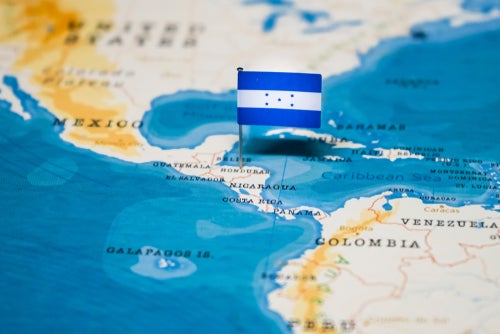
During the first eight months of 2022, Honduras exported US$2.23bn in finished textiles and apparel to the US, of which US$1.57bn’s worth was sold under special access provided by the CAFTA-DR (Central America-Dominican Republic Free Trade Agreement), according to OTEXA, the US Office of Textiles and Apparel with volumes up 15.3% to 87 MM2.
By contrast, Mexico, shipped $4.3bn in the first eight months of this year 2022. Honduras, which maintains a multi-party democracy, despite high crime rates, is the leading supplier to the US of clothing and textiles in the CAFTA-DR region, followed by Nicaragua ($1.74bn), El Salvador ($1.39m), Guatemala ($1.36m), the Dominican Republic ($522m), and Costa Rica ($42.5m).
That is why it is no surprise the clothing and textile industry is the leading export sector in Honduras, directly responsible for 7% of the country’s GDP, delivering 173,000 jobs, according to the Honduran Association of Manufacturers (AHM -Asociación Hondureña de Maquiladores), the country’s key clothing and textile industry group.
Indirectly, the sector supports 29% of Honduran GDP, and delivers 83,000 jobs in supporting sectors, such as transport. Currently, 19 textile and apparel major manufacturing companies are operating in the country, while there are 273 manufacturing companies, said the AHM.
These companies are the centre of an ecosystem that keep Honduras solvent – around 31 major companies in Honduras supply everything to the sector: from machines, buttons, threads, and labels to plastic bags, elastics, and zippers. These suppliers also assist in manufacturing clothing and textile inputs for many foreign companies. And with the US looking to import goods closer to home given the transport problems and inflation caused by the pandemic and fuelled by Russia’s bloody invasion of Ukraine, the Central Bank of Honduras says US imports of all goods from Honduras grew faster than expected in H1 2022, by 6.7% year-on-year.
This success has built on 2021 exports from the Honduras apparel and textile industry, which grew thanks to increased demand, again mainly in the US, with the AHM saying growth in industry exports that year was at 8.6% compared to 2019, just before the pandemic struck. Major export products with the highest export rates include t-shirts, socks, sweatshirts, and cotton shirts it told Just Style.

US Tariffs are shifting - will you react or anticipate?
Don’t let policy changes catch you off guard. Stay proactive with real-time data and expert analysis.
By GlobalDataHonduras is also a key buyer of yarn from the US, with $1bn’s worth of imports purchased, equivalent to 23% of the total US yarn sales, the AHM told Just Style.
The United States Trade Representative (USTR) office noted in 2019 that Honduras imported cotton from the US worth $719m and synthetic staple fibre. This has been fuelled by growth in Honduras’ upstream fabric sector, which the AMH stressed shows how Honduras has achieved solid “vertical integration of its textile industry, which is an essential part of the trading and strategic relationship between Honduras and the United States”.
Honduras’ sales have also been strengthened by the country’s Free Zones Law, which strengthens the competitiveness of the Honduran textile industry, according to AHM president Mario Canahuati. The regime gives companies in the designed sectors tax advantages for 15 years, with an option to renew the benefits for another 10 years.
It also shortens administrative procedures to secure operating approvals from eight months to just one, by centralising bureaucratic operations in one institution.
In addition, the country benefits from 24/7 ports, relatively close to the US – only three days sailing is needed to move containers from Honduras’ main Caribbean Sea port, Puerto Cortés, to Port Everglades, in Florida, Houston, or Miami.
Such advantages have motivated companies such as the North Carolina-based manufacturing major Parkdale Mills to announce plans to invest $150m in a new spinning mill in Villanueva, near Puerto Cortés, but no further information has been given. In addition, the company will allocate $24m’s worth of its investment to ensure its manufacturing plants in Honduras use solar energy-efficient systems and become more environmentally friendly.
Another example is SanMar, a US-based clothing wholesaler, which said last December (2021) it would increase its purchases of products made in northern Central America, mostly Honduras, from now until 2025. This commitment will mean more manufacturing in Honduras, specifically an additional 4,000 full-time jobs at Elcatex, a clothing manufacturer based in Choloma, also near Puerto Cortés, partly-owned by SanMar.
The AMH’s Canaguate believes upcoming textile and clothing investment will generate at least 15,000 jobs in the country in the coming five years. Nevertheless, overstocking, a likely US recession and high US inflation have cast their shadow on Honduras. In September, Hanesbrands announced it would close its Jasper plant, in Choloma, Honduras, as of November 2022, losing 1,700 jobs.
Other companies have halted their orders, said the AMH, but how this will impact Honduras’ export figures for H2 2022 remains to be seen.



